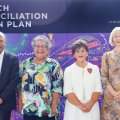The University of Queensland's support for PhD students has been rewarded with a 34 percent increase in completions in 1996.
Completions reached 300 in 1996 - up from 224 the previous year.
According to the University's Dean, Postgraduate Studies, Professor David Siddle, the 300 PhD and 107 research masters completions for 1996 is believed to be among the highest for Australian universities.
In addition, the average completion time from enrolment to submission of PhD theses was 3.7 years - an excellent result, he said.
Professor Siddle said he believed the key to the University's success in attracting and graduating so many postgraduate students lay in its superior facilities, learning opportunities and effective supervision.
'We have excellent intellectual and physical resources to support postgraduate research. We are a very strong university in terms of research and because postgraduate studies are fostered by nodes of active research then it follows that we attract good postgraduate students and foster high-level postgraduate work,' he said.
'We also have a very strong collaborative base with industry in our research and that means opportunities for research students to carry out PhD and masters research which is industrially oriented.
'In 1996, the Postgraduate Research Studies Committee developed a comprehensive policy on the role and responsibilities of supervisors of research higher degree students.
'The Committee has also embarked on a program assessing the resource infrastructure needs (for example, computers) of all higher degree students and addressing any deficiencies.'
He said the University also continued to fund HECS exemptions for research higher degree students and allocated around $900,000 to fund University of Queensland Postgraduate Research Scholarships (UQPRS) for students commencing in 1997.
Professor Siddle said the University was constantly looking for new ways to improve the service offered to prospective and existing postgraduate students and had developed a detailed prospectus outlining for potential students exactly what the University offers in its PhD and research masters programs.
Overseas students were represented at the same level as Australian students in both PhD completions and the proportions of postgraduate students engaged in PhD studies.
Professor Siddle said 15 percent or 46 of the PhDs had been completed by international students.
'This figure exactly matches the 15 percent of total PhD students who are international students so their performance and contribution to the University's research program is at the same level as Australian students,' he said.
'The proportion of international students in the PhD program is much higher than the proportions of international students in undergraduate courses. Many of these PhD students come from South-East Asia.'
For more information, contact Professor Siddle on (07) 3365 3477.



